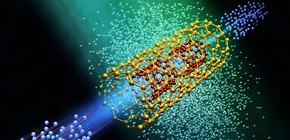
Successful generation of high-quality proton beam with CNT particle accelerator
Under the leadership of MURAKAMI Masakatsu , Professor, Institute of Laser Engineering, Osaka University, and TANAKA Motohiko , Professor, School of Engineering, Chubu University, a group of researchers discovered a new particle acceleration mechanism in which, when a strong laser irradiated to nanotubes filled with hydrogen compound, hydrogen ions, protons with high coherence and directionality, were ejected from both ends of nanotubes. Detailed three-dimensional numerical simulations demonstrated that acceleration principle of nanotubes produced proton beam with high monochromaticity and directionality.
Research into proton beams will lead to the possible development of super compact particle cancer therapy equipment, the development of compact neutron source mediated by fusion reaction as well as applications in fuel batteries and materials to industry.
Carbon nanotubes have unique electrical and mechanical features. Therefore, a variety of basic research and industrial applications as electronic devices and functional materials have been promoted since their discovery. This group's discovery clarified that femto scale (1-100 trillionths seconds) carbon nanotubes can be used as particle accelerators under the extreme physical environment of hundreds of millions of degrees. It will also give birth to new interdisciplinary fields of study such as high energy physics, high power laser technology, and nano materials.
Abstract
An ion acceleration scheme using carbon nanotubes (CNTs) is proposed, in which embedded fragments of low-Z materials are irradiated by an ultrashort intense laser to eject substantial numbers of electrons. Due to the resultant characteristic electrostatic field, the nanotube and embedded materials play the roles of the barrel and bullets of a gun, respectively, to produce highly collimated and quasimonoenergetic ion beams. Three-dimensional particle simulations, that take all the two-body Coulomb interactions into account, demonstrate generation of quasimonoenergetic MeV-order proton beams using nanometer-size CNT under a super-intense electrostatic field ∼ 10 14 V m −1 .

Figure 1

Figure 2
To learn more about this research, please read the full research report entitled " Generation of high-quality mega-electron volt proton beams with intense-laser-driven nanotube accelerator " at this page of the Applied Physics Letters website.
Related link :

